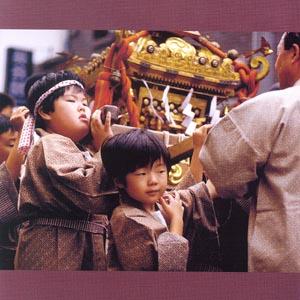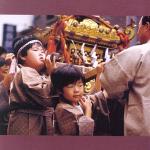Haiku Past and Present
Omikoshi Day
Heave ho and away we go
Tradition lives on
From Five Seven Five by Celeste Heiter and Robert George.
* * * * *
Among the many unique art forms of Japan, haiku is perhaps the most widely known literary form. Composed of seventeen simple syllables, arranged in three lines of five, seven and five syllables each, these elegant poems capture and distill the ephemeral essence of nature and the seasons.
Introduced by Japan's first and most beloved haiku poet Basho Matsuo (1644-1694), haiku had its beginnings in an ancient thirty-one syllable poetic form called tanka. Each tanka verse was composed of five lines of five, seven, five, seven and seven syllables each. As a royal entertainment, courtiers often amused themselves with a game called "verse capping," in which the first three lines of a tanka were presented in five-seven-five form and the players would compete by composing the remaining pair of seven-syllable lines.
In the 15th century, a poetic form called renga emerged from the tanka as a progressive poem composed by a collaboration of several poets. Each participating poet composed and contributed a seventeen-syllable, five-seven-five verse, and a fourteen-syllable, seven-seven verse, alternated for a total of one hundred verses. The renga form is highly formal and academic in both style and content.
Later, during the 16th century, another poetic form called haikai grew in popularity. The haikai form is similar to renga in structure, with alternating verses of seventeen and fourteen syllables each, but features the less rarefied elements of everyday life using low-brow plays on words.
The first verse of both renga and haikai are called hokku, which means "starting verse," and both are composed of seventeen syllables arranged in three lines of five, seven and five syllables each. Haikai poets often presented hokku verses as independent poems, which eventually evolved into its present form, and was given the distinct name haiku by the 19th century poet Shiki Masaoka.
More transcendent than haikai and less academic than renga, a haiku poem traditionally focuses on the observance of a single detail or moment in time that somehow symbolizes the enigmatic beauty and irony of nature and the seasons.
Inspired by the sight of a single cloud drifting on the breeze, the poet Basho set off in 1689 on a five-month pilgrimage to the remote northern Tohoku region of Japan, during which he wrote The Narrow Road to the Deep North, a travelogue of prose and perhaps his finest collection of poetry. Basho and his haiku have since been immortalized in stone along a path of 1100 stairs to the lofty mountain temple known as Hojusan Risshakuji in Yamagata Prefecture near the city of Sendai.
In contemporary Japan, haiku lives on today as a vibrant literary form, composed and enjoyed by both classical scholars and common folk alike. Five Seven Five still thrives.
* * * * *
More from Five Seven Five:
* * * * *
 ThingsAsian
ThingsAsian
















